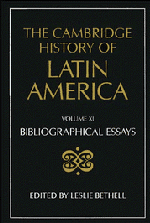Book contents
- Frontmatter
- I THE INDIGENOUS PEOPLES OF MIDDLE AND SOUTH AMERICA ON THE EVE OF THE CONQUEST
- II COLONIAL SPANISH AMERICA
- 1 The Spanish conquest and settlement of America
- 2 Indian societies and the Spanish conquest
- 3 Spain and America in the sixteenth and seventeenth centuries
- 4 Spain and America: The Atlantic trade, 1492–c.1720
- 5 Spain and America in the eighteenth century
- 6 Population
- 7 Urban development
- 8 Mining
- 9 The formation and economic structure of the hacienda in New Spain
- 10 The rural economy and society of Spanish South America
- 11 Aspects of the internal economy: Labour, taxation, distribution and exchange
- 12 Social organization and social change
- 13 Indian societies under Spanish rule
- 14 Africans in Spanish American colonial society
- 15 Women in Spanish American colonial society
- 16 The Catholic church
- 17 Literature and intellectual life
- 18 Architecture and art
- 19 Music
- III COLONIAL BRAZIL
- IV THE INDEPENDENCE OF LATIN AMERICA
- V LATIN AMERICA: ECONOMY, SOCIETY, POLITICS, c. 1820 TO c. 1870
- VI LATIN AMERICA: ECONOMY, SOCIETY, POLITICS, c. 1870 to 1930
- VII LATIN AMERICA: ECONOMY, SOCIETY, POLITICS, 1930 to c. 1990
- VIII IDEAS IN LATIN AMERICA SINCE INDEPENDENCE
- IX LATIN AMERICAN CULTURE SINCE INDEPENDENCE
- X THE INTERNATIONAL RELATIONS OF LATIN AMERICA SINCE INDEPENDENCE
- THE CAMBRIDGE HISTORY OF LATIN AMERICA
18 - Architecture and art
from II - COLONIAL SPANISH AMERICA
Published online by Cambridge University Press: 28 March 2008
- Frontmatter
- I THE INDIGENOUS PEOPLES OF MIDDLE AND SOUTH AMERICA ON THE EVE OF THE CONQUEST
- II COLONIAL SPANISH AMERICA
- 1 The Spanish conquest and settlement of America
- 2 Indian societies and the Spanish conquest
- 3 Spain and America in the sixteenth and seventeenth centuries
- 4 Spain and America: The Atlantic trade, 1492–c.1720
- 5 Spain and America in the eighteenth century
- 6 Population
- 7 Urban development
- 8 Mining
- 9 The formation and economic structure of the hacienda in New Spain
- 10 The rural economy and society of Spanish South America
- 11 Aspects of the internal economy: Labour, taxation, distribution and exchange
- 12 Social organization and social change
- 13 Indian societies under Spanish rule
- 14 Africans in Spanish American colonial society
- 15 Women in Spanish American colonial society
- 16 The Catholic church
- 17 Literature and intellectual life
- 18 Architecture and art
- 19 Music
- III COLONIAL BRAZIL
- IV THE INDEPENDENCE OF LATIN AMERICA
- V LATIN AMERICA: ECONOMY, SOCIETY, POLITICS, c. 1820 TO c. 1870
- VI LATIN AMERICA: ECONOMY, SOCIETY, POLITICS, c. 1870 to 1930
- VII LATIN AMERICA: ECONOMY, SOCIETY, POLITICS, 1930 to c. 1990
- VIII IDEAS IN LATIN AMERICA SINCE INDEPENDENCE
- IX LATIN AMERICAN CULTURE SINCE INDEPENDENCE
- X THE INTERNATIONAL RELATIONS OF LATIN AMERICA SINCE INDEPENDENCE
- THE CAMBRIDGE HISTORY OF LATIN AMERICA
Summary
Among the pioneers in writing the history of the art and architecture of colonial Spanish America, the prominent figures in Mexico were Manuel Romero de Terreros, with his Historia sintética del arte colonialx (Mexico, D.F., 1922), and Manuel Toussaint, author of the classic Arte colonial en México, 2nd ed. (Mexico, D.F., 1962); Eng. trans. Colonial Art in Mexico, (Austin, Tex., 1967). A comparable role was played in Peru by the architect Emilio Harth-terré, whose numerous articles have been collected into one volume: Perú: Monumentos históricos y arqueologicos (Mexico, D.F., 1975). See also Héctor Velarde, Arquitectura peruana (Mexico, D.F., 1946) for a number of interesting points of view. In Argentina there were three early specialists: Angel Guido, Martín S. Noel and Miguel Solá. Guido was a theorist who made his name with Eurindia en el arte hispanoamericano (Santa Fe, Arg., 1930). Noel, architect, theorist – see his Teoría histórica de la arquitectura virreinal (Buenos Aires, 1932) – and connoisseur, was most importantly the editor of a series of studies entitled Documentos de arte colonial sudamericano, published in Buenos Aires between 1943 and 1957 by the Academia Nacional de Bellas Artes. The most comprehensive and coherent work was Miguel Solá, Historia del arte hispanoamericano (Barcelona, 1935). The major work, however, was to be that undertaken by a Spanish historian, Diego Angulo Iñíguez, the chief author of a monumental Historia del arte hispanoamericano, 3 vols. (Barcelona, 1945–56), in which he was assisted by another Spaniard, Enrique Marco Dorta, and by the Argentine architect Mario José Buschiazzo.
- Type
- Chapter
- Information
- The Cambridge History of Latin America , pp. 153 - 160Publisher: Cambridge University PressPrint publication year: 1995



